original on web-site of UEBB (pdf-file)
The test of behaviour recommend UEBB 2003
1. Behaviour towards people (during judging of standard or during measurement)
While measuring the dog or during the standard-judging, the behaviour of the dog in this situation is observed.
Evaluation:
1 point: The dog shows fear or aggression even at a distance. To movements and voices it reacts unreasonably strong.
- with body language unambiguously showing fear, the dog evades the person (tail clamped under belly, crouches, trembles)
- or the dog is clearly aggressive (snarling, teeth showing, attacking, snapping)
Thereby the dog seems to panic and can be controlled only through continuous influence from the handler.
- or the dog seems to freeze, or seems apathetic, and cannot be influenced any longer except through physical influence from the handler.
The dog presented cannot be judged completely.
2 points: The dog shows uncertainty or nervousness during direct manipulation and during observation from a distance.
At the same time it evades the tester continuously, shows anxiety and uncertainty, or it shows a tendency for aggressiveness.
It can be influenced however through continuous help from the handler in a way that the dog can be judged completely.
3 points: The dog is somewhat uncertain during direct manipulation and respectively has to be controlled (subordinated) for a moment.
During the observations from a distance the dog is relatively self-confident and attentive. It can be easily influenced through voice and other helpful stimulation.
4 points: The dog shows that it is calm and relatively self-confident.
During direct manipulation it is possible that it is shortly irritated, but it immediately afterwards shows itself tolerant and certain.
During observations from a distance the dog is calm, attentive and sure of itself.
5 points: The dog is absolutely calm and alert; is receptive and actively friendly during manipulation.
2. Behaviour towards people (during behaviour testing)
During the complete course of the behaviour test the dog's behaviour towards strangers is observed.
Evaluation:
1 point: If the dog among strangers:
- shies away or shrinks back when strangers pass him passively at a distance of at least 5 m and the dog shows body language which is unambiguously insecure or fearful
- shows itself fearful-aggressive.
2 points: If the dog shies away from strangers passing him in a passive way, but the dog can be influenced and stabilized by its handler in such a way that the entire behaviour test can be carried on.
3 points: If the dog shows neutral behaviour in a group of moving people and is only slightly uncertain when contacted directly.
During this the dog can be influenced easily (by its handler).
4 points: If the dog shows itself secure and attentive in a group of moving people, tolerates incidental voice or bodily contact.
While being addressed by its handler, the dog allows calm bodily contact from strangers without being impressed.
5 points: If the dog, without being influenced by its handler, permits active contact from strangers, showing self-confidence, calmness, attentiveness and active friendliness.
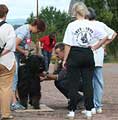
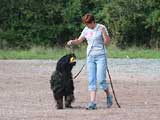
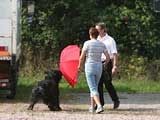
3. Playing with the handler
The unleashed dog is supposed to play with the handler and a toy or without a toy.
The handler as a person can very well be an active toy himself. In this case a bond between the dog and handler must be obvious.
Evaluation:
1 point: The dog plays neither with the toy nor with its handler and shows no interest in a mutual activity with the handler.
2 points: The dog follows the handler and his movements but shows little inclination to play with the handler or the toy.
3 points: The dog follows the toy or handler actively and isn't distracted at all (or only shortly in a calm environment) from the game.
4 points: The dog follows the toy or handler actively, seeks a game, and isn't distracted (or only shortly distracted) by behaviour testers which move around him.
5 points: The dog follows the toy or handler actively, constantly demands that the handler play with him, and is not distracted by behaviour testers which move around it.
4. Playing with strangers
The behaviour tester takes over the toy from the handler and dog during their play by turning away from the dog, and during the take-over there are no movements directly against the dog, no eye-contact with the dog, and no leaning over the dog.
This take-over of the toy is like a change of staff in a relay race.
The handler remains passive after the take-over by the tester.
Evaluation:
1 point: The dog doesn't accept the stranger (tester) nor the toy.
2 points: The dog follows the tester/ toy in his/ its movements but doesn't show much or any inclination to play with the tester or the toy.
3 points: The dog follows the tester/ toy actively and is not (or only shortly) distracted from his game by a calm environment (other people in the background).
4 points: The dog follows the tester/ toy actively, actively seeks to play and is not (or only very shortly) distracted by other people which move around him.
Also, the behaviour tester is able to move with and against the movements of the dog (give and take), while the dog plays.
5 points: The dog not only follows the tester/ toy actively, but continuously demands play and is not distracted by a group of people which is moving around it.
The behaviour tester can move with or against the movement of the dog (and the dog remains persistently in a play mode).
The dog continuously demands activity and the behaviour tester can fight for the toy for a short time, and pull on the toy with one hand while simultaneously make stroking movements with his hand over the dog's head - either from a leaning or a standing position.
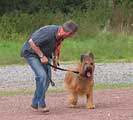
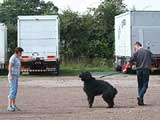
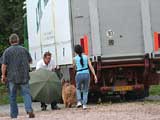
5. Optical impressions
Optical impressions are created with stretched bed sheets, table cloths, foils, streamers, umbrellas and tunnels etc. that the dog could encounter in every-day life.
Evaluation:
1 point: Very insecure (fearful) the dog panics without showing any bond whatsoever to its handler (flees); or it freezes and remains apparently unimpressed, but is not to be influenced by its owner any more.
2 points: Very insecure (fearful), but showing bonding to its handler and the willingness to be influenced by him immediately in such a way that the dog can be tested further.
3 points: Somewhat insecure, but can be immediately influenced by its handler, so that the dog remains through the rest of this test part within about 5 m of its handler.
4 points: It is obvious that the dog registers the objects, but it shows interest or neutral behaviour for these objects without the continuous influence from its handler.
5 points: The dog is calm and alert throughout, unimpressed by the objects, showing neutral behaviour or interest.
6. Acoustical impressions
For acoustical impressions, objects (metal cans, plastic bottles, horns, etc.) which make various every-day noises are used at a station.
Noise makers are not thrown or activated directly at the dog, but only at an appropriate distance.
Evaluation:
1 point: Very insecure (fearful) the dog panics without showing any bond whatsoever to its handler (flees); or it freezes and remains apparently unimpressed, but is not to be influenced by its owner any more.
2 points: Very insecure (fearful), but showing bonding to its handler and the willingness to be influenced by him immediately in such a way that the dog can be tested further.
3 points: Somewhat insecure, but can be immediately influenced by its handler, so that the dog remains through the rest of this test part within about 5 m of its handler.
4 points: It is obvious that the dog registers the objects, but it shows interest or neutral behaviour for these objects without the continuous influence from its handler.
5 points: The dog is calm and alert throughout, unimpressed by the objects, showing neutral behaviour or interest.
7. Acoustical impressions / Shot
The handler walks with his dog (without leash) on a prescribed route.
The handler may talk to his dog, and encourage it, but is not allowed to subordinate it with strong commands.
Two shots are fired from a distance of about 30 m as the team walks leisurely towards or by the tester - there's no shooting from the rear of the dog.
Evaluation:
1 point: Very insecure, the dog panics and flees at the first shot without showing any bonding at all to its handler; or it freezes with fright and remains apparently unimpressed but cannot be influenced by its owner any more.
With this reaction there is no second shot.
2 points: Very insecure, the dog may flee with fright but quickly shows a bonding to its handler by returning and thus a willingness to be influenced by the handler so that the dog can be tested further.
3 points: Somewhat insecure or visibly impressed, but can be immediately influenced by its owner, thus remaining for the rest of this test part within about 5 m of its handler.
4 points: It is obvious that the dog registers the shot, but it shows neutral behaviour or interest without continuous influence by the handler.
5 points: Attentive but unimpressed, the dog continues walking with its owner.
8. Temperament
During all test parts, especially during the running part, the love of movement (an aspect of the dog's reactivity or general activity) under the handler's control - that is, the temperament of the dog is observed.
Running Part: Requires 15 laps (1 lap is about 100 m); the first lap at walking speed, then a lap at a medium trot (the dog is trotting); after each lap the dog's gait alternates - walk then trot - (one lap of gallop can be asked for).
The tester may indicate rapid changes of gait at indicated positions within a lap.
Normally 4 dogs are tested in a group, with each dog-handler team positioned with an even distance around a circle or oval.
Evaluation:
1 point: The dog can not be influenced, is very nervous or panic-stricken, shows extreme reactions to every-day stimulus, stoic, disinterested, or evades reactions to every day stimulus (freezes, or turns off).
During the running part, the dog, which has been presented as healthy, shows sluggish movements and lags behind.
The handler has to adapt his speed to the dog to avoid its staying behind, and respectively use strong control to avoid the dog's stopping.
2 points: The dog can be influenced only a little, is nervous, it shows sluggish, tired movements and needs a lot of strong stimulus to get it into action.
During the running part the dog needs a lot of stimulus to keep up.
3 points: The dog can be influenced by its handler and needs active stimulation.
During the running part the dog moves along showing its love of movement and needs little stimulus apart from calling for its attention in order to get started or change gait.
4 points: The dog can be influenced by its handler, demands action, is active and remains guidable in its activities.
During the running part the dog moves along showing its love of movement and needs little stimulus apart from calling for its attention in order to get started or change gait.
5 points: The dog can be influenced by its handler and insisting asks for action, demands activity and remains obviously influenced even in strong activity.
During the running part the dog moves along showing its love of movement and doesn't need any stimulus apart from calling for its attention in order to get started or change speed.
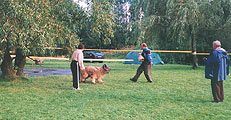
9. Irritation/Courage
The behaviour-tester welcomes (shakes hands with the handler) and takes him and his unleashed dog on a short „walk“ to a prescribed place.
There the dog is tied standing up to something (e.g., a tree).
The behaviour-tester explains this test part and then returns to a group of people about 15 m away.
Test Execution: The handler stands in front of his tied dog keeping a distance of about 3 m.
He is allowed to talk to his dog.
An irritation consisting of noises and movements from the behaviour-tester is directed at the dog and its handler starting at a distance of about 30 m.
The tester makes hectic, unnatural movements, using a loud voice and aids like an umbrella or a stick.
During this irritation from noises and movements, the tester moves in the direction of the dog, as he increases the stress level of irritation into situations near the dog where courage is to be demonstrated.
During the course of all behavioural test parts, as well as during this irritation test part, the dog's attentiveness as well as its inclination to be aggressive and its stimulus threshold are observed.
Evaluation:
1 point: At the onset of tester-irritation the dog reacts inappropriately, reacting very insecure (frightened) or insecure-aggressive towards the tester as well as the group of people who behave with ordinary talking in a natural posture with calm and appropriate movements.
2 points: During irritation, the dog reacts even before a close area (= distance of about 5 m to the dog)
- with an insecure (frightened) body language, or
- with an insecure-aggressive body language, or
- with an insecure-aggressive body language, with back and forth movements from his place, or
- it evades the realisation of the irritation, freezing apparently without emotion.
If the dog retreats a couple of steps, circles around its place, sits down or lies down or jumps into the leash in an unfortunate manner so that it is impressed by its own action, but observes the irritation attentively and securely, no evaluation takes place yet.
3 points: During the irritation at the close area, the dog remains in place.
It accepts the irritation for at least 10 seconds, after which it may show some insecurity, in which case the tester stops the irritation immediately and runs away from the dog into the group of people.
4 points: During the irritation the dog remains in place even with the tester inside the close area.
It accepts the irritation for at least 10 seconds, after which it may become insecure, in which case the tester stops the irritation immediately and runs away from the dog into the group of people.
5 points: If the dog accepts the irritation within the close area for at least 10 seconds and does not become insecure, the tester moves sidewards from the dog about 10 m in order to put the dog, if it follows him, into a situation of "loneliness" without the assuring closeness of its handler.
If the dog accepts the irritation in this situation for at least 10 seconds and doesn't become insecure, the tester terminates the irritation and runs away from the dog into the group of people.
10. Calming down
Immediately after the test part for irritation-courage, another behaviour-tester goes up to the handler, at the side of his dog and explains the following test sequence.
The handler unleashes his dog and together they walk into a group of people who are talking to each other at an ordinary level of noise.
The group of people make a circle around the handler and his dog, keeping a distance of 1 to 2 m.
Here the handler can hold his dog by its collar, can talk to it, and have it sit down or remain standing.
The group open and close the circle (within about 1 - 2 m distance) around the dog several times slowly and quickly.
During this action the people talk at an ordinary level of noise and clap their hands.
The handler is then given a cord or light leash while he's within the circle to attach to the dog.
The handler hands over the leash to a tester who then holds the dog.
The handler then departs the group and goes to a prescribed position at about 30 m distance and calls his dog, at which point the tester releases the dog.
Then the handler and unleashed dog return together into the moving group of people.
During these activities the handler is allowed to talk to his dog and influence it, but without any strong commands.
During all test parts - and especially after the irritation test part - the calming down of the dog is observed.
The force and the duration of the stimuli, as well as the distance to the dog, are relevant for the evaluation.
Evaluation:
1 point: After optical and acoustical stimuli, movements and meetings of every-day life, and the irritation test part, the dog does not calm down within 3 minutes.
It can not be influenced or calmed down by its handler.
2 points: After optical and acoustical stimuli, movements and meetings of every-day life, and the irritation test part, the dog calms down within 3 minutes.
It can be influenced by its handler.
3 points: After optical and acoustical stimuli, movements and meetings of every-day life, and the irritation test part, the dog calms down, appropriate to the stimulus, within less than 1 minute.
It can be easily influenced by its handler.
4 points: After optical and acoustical stimuli, movements and meetings of every-day life, and the irritation test part, the dog calms down, appropriate to the stimulus, within a few moments.
It can be easily influenced by its handler.
5 points: After optical and acoustical stimuli, movements and meetings of every-day life, and the irritation test part, the dog calms down immediately.












